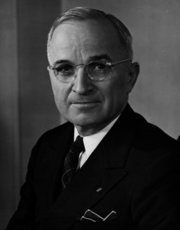Vice President of the United States
|
|
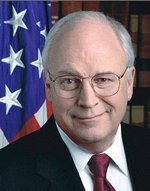 Richard B. Cheney, 46th Vice President of the United States |
The Vice President of the United States is the second-highest executive official of the United States government, the person who is "a heartbeat from the presidency". As first in the presidential line of succession, the Vice President becomes the new President of the United States upon the death, resignation, or removal by impeachment and subsequent conviction of the President. Eight Vice Presidents have assumed the Presidency upon the death of the President, and one upon the President's resignation.
The current Vice President of the United States is Dick Cheney.
Beyond this role, the only duty required by the U.S. Constitution is that the Vice President serve as the President of the Senate. Since 1974, the official residence of the Vice President and his family has been Number One Observatory Circle, on the grounds of the United States Naval Observatory in Washington, DC. The government jargon that often acronymizes the President of the United States as "POTUS" similarly applies "VPOTUS" to the Vice President. More casual news sources, such as weblogs often abbreviate the title to "Veep".
| Contents |
Constitutional requirements
Johnadamsvp.flopped.jpg
To hold the office, the Vice President must satisfy the same constitutional qualifications as the President; that is, the Vice President must be a natural-born citizen of the United States, at least thirty-five years of age, and a resident of the United States for 14 years.
The Vice President-Elect takes office just before the President-Elect. Unlike the President, the Constitution does not specify an oath of office for the Vice President. Several variants of the oath have been used since 1789; the current form, which is also recited by Senators, Representatives and other government officers, has been used since 1884:
I do solemnly swear (or affirm) that I will support and defend the Constitution of the United States against all enemies, foreign and domestic; that I will bear true faith and allegiance to the same; that I take this obligation freely, without any mental reservation or purpose of evasion; and that I will well and faithfully discharge the duties of the office on which I am about to enter: So help me God.
President of the Senate
As President of the Senate (Article I, Section 3), the Vice President oversees procedural matters and is given the ability to cast a vote in the event of a tie. There is a strong convention within the U.S. Senate that the Vice President not use his position as President of the Senate to influence the passage of legislation or act in a partisan manner, except in the case of breaking tie votes. In fact, the Vice President is constitutionally prevented from voting except in the case of ties. In practice, the Vice President rarely presides over day-to-day matters in the Senate; in his place, the Senate chooses a President pro tempore (or "president for a time") to preside in the absence of the Vice President.
One duty required of President of the Senate is presiding over the counting and presentation of the Presidential and Vice Presidential electoral votes by the U.S. Electoral College, in the presence of both houses of Congress, on January 6 of the year following a U.S. presidential election. In this capacity, only four Vice Presidents have been able to announce their own election to the Presidency: John Adams, Thomas Jefferson, Martin Van Buren, and George H. W. Bush.
Though he was President of the Senate, Vice President John C. Calhoun believed he would have more power as a Senator. When he was elected to the Senate from his native South Carolina, he became the first Vice President to resign the office.
Election process
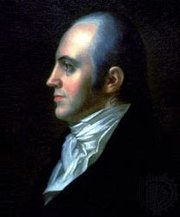
Under the U.S. Constitution, the members of the U.S. Electoral College originally voted only for office of President rather than for both President and Vice-President. The person receiving the greatest number of votes (provided that such a number was a majority of electors) would be President, while the individual who was in second place became Vice President. If no one received a majority of votes, then the U.S. House of Representatives would choose between the five highest vote-getters, with each state getting one vote. In such a case, the person who received the highest number of votes but was not chosen President would become Vice President. If there was ever a tie for second, then the U.S. Senate would choose the Vice President.
The original plan, however, did not forsee the development of political parties. In 1796, for instance, Federalist John Adams came in first, and Democratic-Republican Thomas Jefferson came second. Thus, the President and Vice President were from different parties. An even greater problem occurred in the election of 1800, when Democratic-Republicans Jefferson and Aaron Burr tied the vote. While it was intended that Jefferson was the Presidential contender and Burr was the Vice Presidential one, the electors did not and could not differentiate between the two under the system of the time. After 35 unsuccessful votes in the U.S. House of Representatives, Thomas Jefferson finally won on the 36th ballot and Burr became Vice President.
John_Tyler.jpg
The tumultuous affair led to the adoption of Amendment XII in 1804, which directed the electors to use separate ballots to vote for the President and Vice President. While this solved the problem at hand, it ultimately had the effect of lowering the prestige of the Vice Presidency, as the Vice President was no longer the second choice for President.
The Constitution also prohibits electors from voting for both a Presidential and Vice Presidential candidate from the same state as themselves. In theory, this might deny a Vice Presidential candidate with the most electoral votes the absolute majority required to secure election, even if the Presidential candidate is elected, and place the Vice Presidential election in the hands of the Senate. In practice, this requirement is easily circumvented by having the candidate for Vice President change the state of residency as was done by Dick Cheney who changed his legal residency from Texas to Wyoming in order to run for election as Vice President alongside George W. Bush.
Formally, the Vice-Presidential candidate is nominated by the party convention. However, it has long been the custom that the Vice-Presidential candidate has been effectively named by the Presidential candidate. Often, the Presidential candidate will name a Vice-Presidential candidate to bring geographic or ideological balance to the ticket or to appeal to a particular constituency.
Role of the Vice President
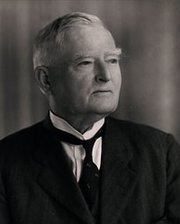
Growth of the office
For much of its existence, the office of Vice President was seen as a little more than a minor position. John Adams, the first Vice President, described it as "the most insignificant office that ever the invention of man contrived or his imagination conceived." Even 150 years later, 32nd Vice President John Nance Garner famously described the office as "not worth a pitcher of warm piss" (at the time reported with the bowdlerization "spit"). Thomas R. Marshall, the 28th Vice President, lamented: "Once there were two brothers. One went away to sea; the other was elected Vice President of the United States. And nothing was heard of either of them again." The natural stepping stone to the Presidency was long considered to be the office of Secretary of State. It has only been fairly recently that this notion has reversed; indeed, the notion was still very much alive when Harry S. Truman became the Vice President for Franklin D. Roosevelt.
For many years, the Vice President was given few responsibilities. After John Adams attended a meeting of the President's Cabinet in 1791, no Vice President did so again until Thomas Marshall stood in for President Woodrow Wilson while he travelled to Europe in 1918 and 1919. Marshall's successor, Calvin Coolidge, was invited to meetings by President Warren G. Harding. The next Vice President, Charles G. Dawes, was not invited after declaring that "the precedent might prove injurious to the country." Vice President Charles Curtis was also precluded from attending by President Herbert Hoover.
In 1933, Roosevelt raised the stature of the office by renewing the practice of inviting the Vice President to cabinet meetings, which has been maintained by every President since. Still, Roosevelt kept his last Vice President Harry S. Truman uninformed on some national security issues. As a result, Truman was unaware of the top-secret Manhattan Project to develop nuclear weapons when he succeeded to the Presidency upon Roosevelt's death in 1945 while World War II was still raging. The necessity of keeping Vice Presidents informed on national security issues became clear, and Congress made the Vice President one of four statutory members of the National Security Council in 1949.
In October 1952, Presidential candidate Adlai Stevenson sought to magnify the importance of the number two position in the executive branch when he said, "The Republican Vice Presidential Candidate ... asks you to place him a heartbeat from the Presidency," referring to Dwight D. Eisenhower's vice presidential running mate, Richard Nixon.
Once elected, President Eisenhower raised the stature of the Vice Presidency further when he ordered Vice President Nixon to preside at Cabinet meetings in his absence.
Modern role
The formal powers and role of the Vice President with a healthy, functioning President are limited to the Presidency of the Senate, including a casting vote in the event of a deadlock. This was important in the first half of 2001, as the Senators were divided 50-50 between Republicans and Democrats and thus Dick Cheney's casting vote gave the Republicans the Senate majority.
Their other functions are as a spokesperson for the administration's policy, as an adviser to the President, and as a symbol of American concern or support. Their influence in this role depends almost entirely on the characteristics of the particular administration. Cheney, for instance, is widely regarded as one of George W. Bush's closest confidantes. Often, Vice Presidents will take harder-line stands on issues to ensure the support of the party's base while deflecting partisan criticism away from the President. Other times their primary role seems to be meeting heads of state or attending state funerals in other countries, at times when the administration wishes to demonstrate concern or support without having to actually send the President himself to do so.
Normally, candidates for President will name a candidate for Vice President when they are assured of the party's nomination. Since the Presidential candidate is now generally known before the party convention, this announcement is now typically made in the first day or so of the party convention. Generally, the choice of running mate is ultimately made by the Presidential candidate alone (although with considerable counsel from advisors) and often is done to create balance on a ticket. It is common for the Vice Presidential candidate to come from a different region of the country than the President or appeal to a slightly different ideological wing of the party.
In recent years, the Vice Presidency has frequently been used to launch bids for the Presidency. Of the 13 presidential elections from 1956 to 2004, 9 featured the incumbent President; the other 4 (1960, 1968, 1988, 2000) all featured the incumbent Vice President. Former Vice Presidents also ran, in 1984 (Walter Mondale), and in 1968 (Richard Nixon, against the incumbent Hubert Humphrey).
Succession and the 25th Amendment
The U.S. Constitution provides that should the President die or become disabled while in office, the "powers and duties" of the office are transferred to the Vice President. It remained unclear as to whether the Vice President actually became the new President or merely Acting President. This was first tested in 1841 with the death of President William Henry Harrison. Harrison's Vice President, John Tyler, asserted that he should gain the full Presidential office, powers, and title. Despite some strong calls against it, Tyler took the oath of office, becoming the tenth President. Tyler's claim was not challenged legally, and so the precedent of full succession was established.
The Constitution still left several questions unanswered, however. If the Vice President died in office, resigned, or succeeded to the Presidency, there was no process for selecting a replacement, so the office of Vice President remained vacant until the next Presidential election. Additionally, the assassination of President John F. Kennedy in 1963 led to the question of who has the power to declare that the President is unable to discharge his duties, should he become incapacitated. This led to the ratification of Amendment XXV to the U.S. Constitution in 1967.
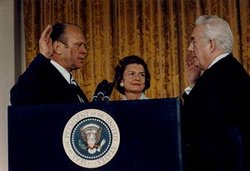
Section 2 of the 25th Amendment provides that "Whenever there is a vacancy in the office of the Vice President, the President shall nominate a Vice President who shall take office upon confirmation by a majority vote of both Houses of Congress." Gerald Ford was the first Vice President selected by this method, after the resignation of Spiro Agnew in 1974; after succeeding to the Presidency, Ford nominated Nelson Rockefeller as Vice President.
Section 3 of the amendment provides means for the Vice President to become Acting President upon the temporary disability of the President. This provision has been invoked twice: on July 13, 1985 when Ronald Reagan underwent surgery to remove cancerous polyps from his colon, and again on June 29, 2002 when George W. Bush underwent a colonoscopy procedure requiring sedation.
Prior to this amendment, Vice President Richard Nixon replaced President Eisenhower on an informal basis three times for a period of weeks each time when Eisenhower was ill.
Vice Presidents of the United States and Presidents of the Senate
Prior to ratification of the 25th Amendment in 1967, no provision existed for filling a vacancy in the office of Vice President; as a result, the position was left vacant 16 times until the next ensuing election and inauguration. Since the adoption of the 25th Amendment, the office has been vacant twice while awaiting confirmation of the new Vice President by both houses of Congress.
Notes:
1 Arriving in New York City before President-elect George Washington, Adams was sworn as Vice President nine days before the President.
2 Died in office
3 Resigned from office
4 Succeeded to Presidency upon death or resignation of President
5 On his deathbed when scheduled to be sworn in, King received special dispensation from Congress to be sworn in twenty days later, while attempting to recover in Havana, Cuba.
6 Became Vice President under provisions of 25th Amendment
7 Acted as President under provisions of 25th Amendment
Vice Presidential facts
Two Vice Presidents served under two different Presidents:
- George Clinton under Thomas Jefferson and James Madison
- John C. Calhoun under John Quincy Adams and Andrew Jackson
Seven Vice Presidents have died in office:
- George Clinton in 1812
- Elbridge Gerry in 1814
- William Rufus de Vane King in 1853
- Henry Wilson in 1875
- Thomas Andrews Hendricks in 1885
- Garret Augustus Hobart in 1899
- James Schoolcraft Sherman in 1912
Two Vice Presidents have resigned from office:
- John C. Calhoun resigned in 1832 to take a seat in the Senate, having been chosen to fill a vacancy.
- Spiro Agnew resigned in 1973 upon pleading no contest to charges of accepting bribes while governor of Maryland.
Nine Vice Presidents succeeded to the Presidency:
- John Tyler became President when William Harrison died a month into office.
- Millard Fillmore became President after Zachary Taylor died in office.
- Andrew Johnson became President when Abraham Lincoln was assassinated.
- Chester A. Arthur became President after James Garfield was assassinated.
- Theodore Roosevelt became President after William McKinley was assassinated.
- Calvin Coolidge became President after Warren G. Harding died in office.
- Harry S. Truman became President after Franklin D. Roosevelt died in office.
- Lyndon Johnson became President after John F. Kennedy was assassinated.
- Gerald Ford became President after Richard Nixon resigned.
Of those who succeeded above, four would later be elected President in their own right:
Gerald Ford was the only vice president who succeeded to the presidency and lost an election for president.
Five Vice Presidents did not succeed to the Presidency but were later elected President in their own right:
- John Adams (1789-1797) was elected President in the 1796 election.
- Thomas Jefferson (1797-1801) was elected President in the 1800 election.
- Martin Van Buren (1833-1837) was elected President in the 1836 election.
- Richard Nixon (1953-1961) was elected President in the 1968 election.
- George H. W. Bush (1981-1989) was elected President in the 1988 election.
There have been three Vice Presidents who had the last name of Johnson:
- Richard M Johnson (1837-1841)
- Andrew Johnson (1865)
- Lyndon Johnson (1961-1963)
Two Vice Presidents have officially acted as President due to presidential incapacity under the 25th Amendment:
- George H. W. Bush acted as President for Ronald Reagan on July 13, 1985.
- Dick Cheney acted as President for George W. Bush on June 29, 2002.
There are currently five living former Vice Presidents:
Of these, Ford and Bush later became President. Mondale and Gore ran for the presidency unsuccessfully.
Related articles
- Vice Presidential Service Badge
- Acting President of the United States
- 25th Amendment
- List of U.S. Vice Presidents by time in office
External links
- Official White House website for the Vice President (http://www.whitehouse.gov/vicepresident/)
- Medical History of American Presidents (http://www.doctorzebra.com/prez/index.htm)


